#batik fabric wax
Text

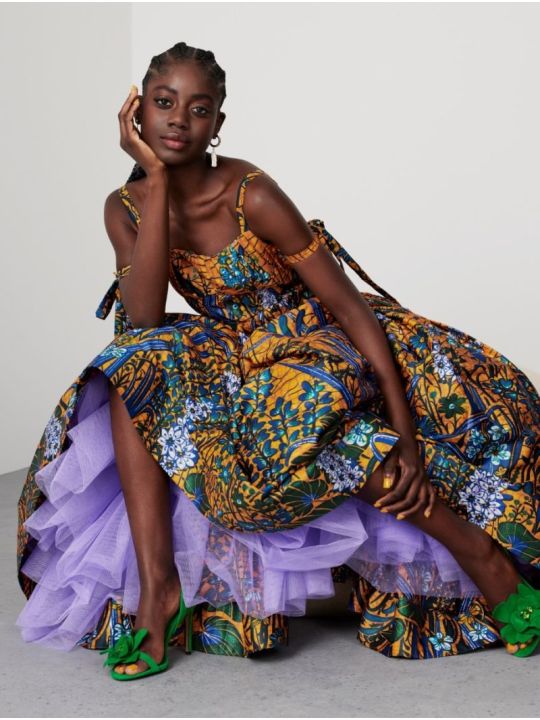
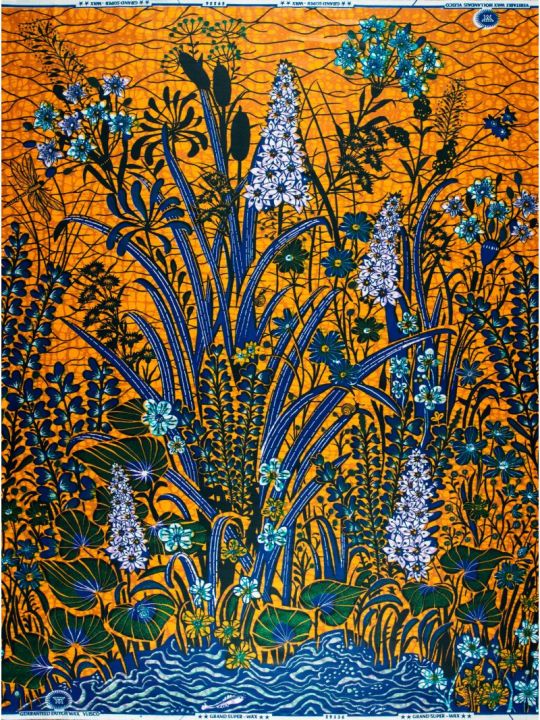


Floral-patterned Grand Super-Wax fabric by Vlisco
'A more exclusive version of Super-Wax, rich in colours and bubbling, and printed with a gloss finish. The most defining (and beloved) feature of a Super-Wax is its duo-colour “bubbling” print effect...
...Grand Super-Wax is a luxurious twist on the original, using Vlisco cotton satin. Grand Super-Wax is made using a highly-unique wax printing technique unlike any other in the world: every piece is created with an unequalled and extraordinary level of care and precision.
First, a design in liquid wax is printed on cotton satin. A base dye such as indigo soaks into the cloth around the wax, leaving behind a deep, intense colour. The magic of the ‘wax-breaking’ during the printing process results in a large, irregular pattern of vein-like bubbles throughout the design.
One single piece of Grand Super-Wax goes through an average of 27 total step before it receives a final gloss finish, and a select number of Grand Super-Wax fabrics are covered from edge-to-edge in transparent glitter.'
#dutch wax#african wax#fashion#dress fabric#pattern#print#vlisco#batik#wax resist#wax print#surface pattern#surface pattern design#pattern design#textile design#textiles#printed textiles#2024#floral#flowers
139 notes
·
View notes
Video
youtube
Fabric and Wax Resist Technique - Material Mondays
Welcome to Week 20, I am sharing how I do my wax resist technique on fabric, I share the steps for creating on fabric.
#youtube#fabric#waxresist#wax resist#batik#fabricart#creativity#textiles#materialmondays#realityarts
0 notes
Text



Results from dyeing the fabric with a solution consisting of both tea and coffee. I’m really happy with how this turned out, I wanted the fabric to still retain its initial appearance but darkening it ever so slightly so that the design would still be visible.

1 note
·
View note
Photo

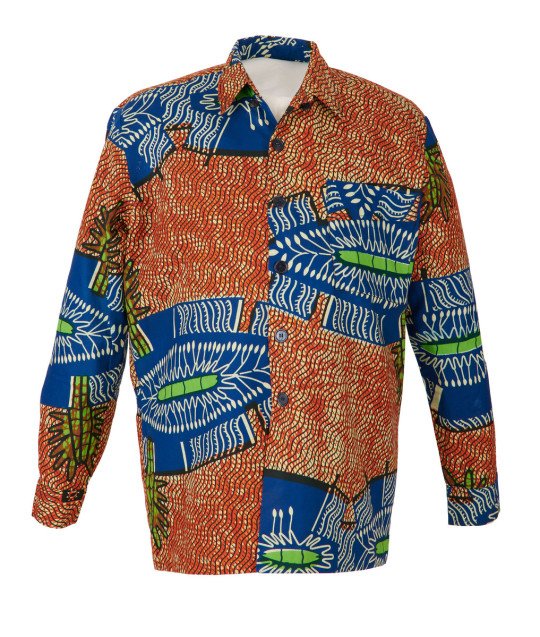


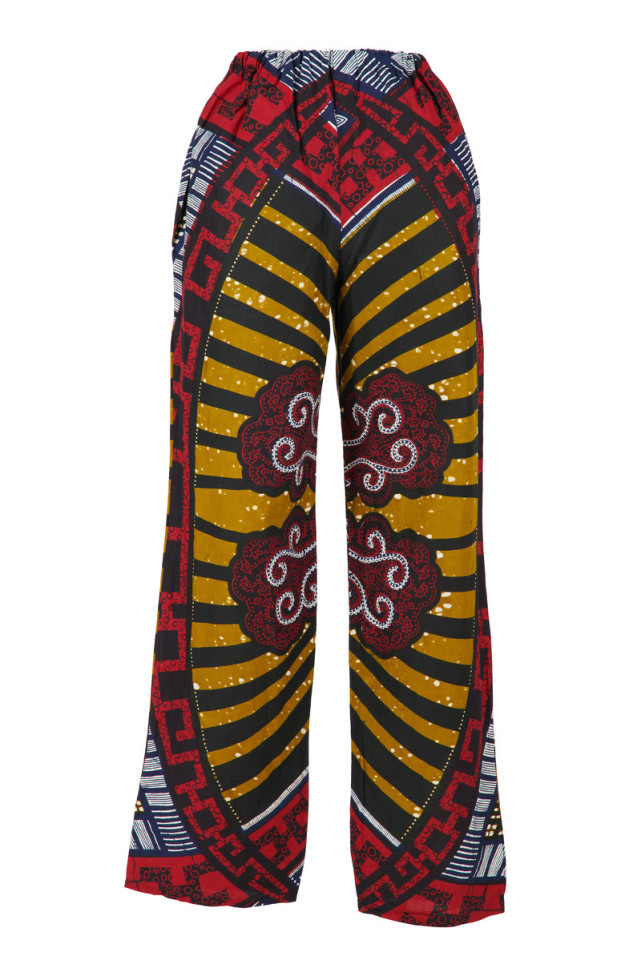

Garments made by ABC Textiles to promote batik (wax print) fabric. Company now owned by Akosombo Textiles Limited in Ghana.
c.1990
Royal Pavilion & Museums, Brighton & Hove
#fashion history#vintage fashion#1990s#non western fashion#dress#blouse#skirt#pants#shirt#batik#20th century#wax print#ghana#west africa#royal pavilion and museums#brighton and hove museums and art galleries
330 notes
·
View notes
Text
also reading about using persimmon as a natural dye across east asia and it's sooooo interesting, i can't wait until persimmon season comes around to try it out i'm really excited
- juice from green persimmons (hachiya especially) contain a large amount of tannins, which is what makes unripe hachiya persimmons so bitter. these tannins are necessary in the dye process
- it's a unique dye because it's UV sensitive and doesn't require heat to set the colour, only sunlight. therefore the goods being dyed only need to be scoured (washed), and don't require a mordant
- the dyeing process is somewhat similar to indigo in that the fabric needs to be dipped in the dye liquid, then left out to dry in the sun to 'cure' the dye, and subsequent dipping and drying in the sun creates deeper shades
- overtime the dye will darken with more UV exposure, so as the dyed fabric ages it will actually increase in colour rather than fade
- persimmon juice makes the fibre stiff but will soften with use
- application of persimmon dye makes the dyed materials water resistant
- the dye on its own is a rusty orange-brown, and dipping persimmon dyed fibre in an iron bath turns it black
- in japan it's traditionally been used to create waterproof paper stencils for fabric printing when combined with a sweet rice paste that prevents dye from binding to covered areas, similar to batik wax technique and other resist dye methods
- it's also been traditionally used in combination with indigo to make purple across east asia
1K notes
·
View notes
Text

An Early Morning Bath At the River ~ batik painting on cotton ~ Exotic India Art
“Wax painting is an art form dating back 2,000 years. Wax Paintings were found in the tombs of Pharaohs and called "mummy portraits". The Indonesian word “Batik” means “wax writing”. In our modern day society wax resist art is usually referred to as “Batik”. The process is also referred to as “Rozome” in Japan. The Japanese version of batik consists of direct application of dyes and wax on silk using silk painting techniques. The Indonesian technique, usually uses cotton or silk and the wax is melted and applied using brushes or tjanting tools to the areas that are to remain that particular color then cloth is immersed into dyes and only the unwaxed areas accept the dye. This wax resist process of waxing out areas and dipping is repeated numerous times. Tjanting tools are made of a wooden shaft with a metal reservoir with a tiny metal tube that allows wax to flow onto the fabric leaving lines or dots. The waxed areas get bent and the cracks or fractures allow the dye to penetrate leaving fine lines of color referred to as “crackle” or “ice”. Janet refers to the crackle as the thumbprint of batik. Some batiks incorporate pastels, silk screening with fabric paint, acrylic paint, colored pencil and other mix media. The wax is removed through ironing the fabric between newsprint which absorbs the wax. The finished batik is dry mounted onto foam core, matted and framed.” ~ from Searfossdesigns
24 notes
·
View notes
Text



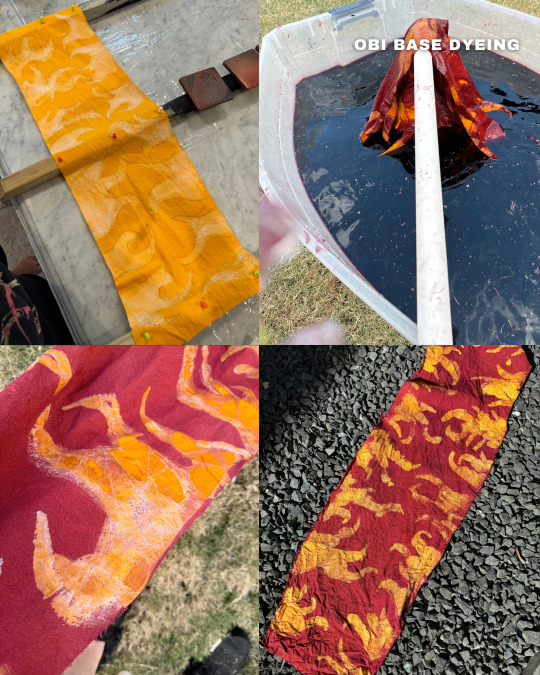

Medicine Seller (Mononoke) Progress - Kimono + Obi: How I Made It
👾 SLEEVES 👾
These are entirely made of damaged or used kimono — and every piece is also dyed to be a similar shade/tone, so the whole thing has deep colors and is cohesive! I got my kimono from Tangerine Mountain kimono and Yoko Beverly Hills primarily; anything not cut or unused was donated to others. All patches are fused with mistyfuse, then sashiko’d on by hand. Fun fact: all the sashiko patterns are tied with the earth or spirits, with the Seven Treasures of Buddhism for the purple, waves of grass for the green, and ocean waves for the blue!
👾 KIMONO FLOWERS 👾
The white flowers were stenciled with Jacquard textile paint in white, before I mixed sodium alginate (a dye thickener) with Dharma Trading Co ’s Teal Blue fiber reactive dye and blended the outlines, making it look a bit more “worn”.
👾 OBI 👾
This was, by and far, the most challenging thing I’ve ever done. I decided to batik (or wax resist) the obi. I started with white raw silk, dyed Golden Yellow with fiber reactive — vinegar has to be added for it to stick better to silks. I then applied the Jacquard wax by brush (all 4 yards of fabric, bless Dharma Trading Co for their amazing brushes), and then — to prevent the yellow from going orange — did another HEAVY wine colored dye bath (Burgundy dye with a touch of Deep Space), LOTS of salt and vinegar to overwhelm the yellow, and it WORKED! I did over 15 different dye tests for this and it WORKED!
👾 KIMONO 👾
This started as the rayon/linen blend fabric from Dharma Trading Co in white. The whole thing was dyed with their fiber reactive dye in Teal Blue, then, I did arashi shibori, or pole-wrapping shibori, with the dye in Navy and Deep Space.
13 notes
·
View notes
Note
🎁: A gift from pretty little liar, to a female hunter. A beautiful handmade Batik dress, a symbol of the sender's country, Indonesia. The patterns portrays the beautiful flora of Indonesia, with the pattern of a Cenderawasih, a beautiful bird of paradise native to Indonesia, at the skirt part of the dress. Along with the dress, the sender has also sent a box of golden jewelry that compliments the dress, consisting of the necklace, earrings, bracelets, a headpiece, and a brooch.
🔔 — THIS GIFT REASONATED WITH...



It's quite rare for the sculptor to be seen mesmerized by something other than her own works. Galatea's eyes sparkle as she raises the dress in front of her while she is sitting on her wheelchair. The smell of wax fills her nostrils and her eyes scan the intricate patterns embedded in the dense fabric.
The more she gaze at your impressive craftsmanship, the more her curiosity grows, and her gratitude heightens. She's heard the process done to make batik arts. How much effort did you put into this? And you were willing to give this as a gift?
Receiving a dress like this from a foreign culture, she is definitely surprised. Galatea has her fair share of knowledge about the arts of the world, she has seen some art exhibits about other cultures and she was also introduced to them when she was still an art student. But she never expected that she would receive one and you'd also give her accessories to complete the whole look.
To be given a work of art such as this as a present, and the amount of effort you've put into this, Galatea is greatly honored. She's definitely taking good care of this dress and the headpiece and accessories that came with it. She will wear it for you, and may or may not be because she wants to show it off to others.

— A letter from Galatea! 📨
Dear pretty little liar,
Thank you truly for this gift. You don't know how astonished I was when I received it. It's perfect. I can see the amount of work you've put into making this. I haven't worn it yet though, not yet. It's a really extravagant dress in my opinion. I want to wear it on a day that's more special than any other.
Do you have more of these? No, I'm not asking to be given more. Although I won't mind seeing more of your work and arts from your culture. I was wondering if you do have one, can you wear it? And then come to me. You will be my muse for my next masterpiece. Do you accept?
I await for your reply,

Galatea Claude


[the gif's quality looks low 🛌. I remember batik arts was one of our art class topics when I was in junior high school. I hope I wrote it right! And you are so cool for this ;0]
#identity v imagines#identity v x reader#idv imagines#idv x reader#identity v#idv#identity v matchups#idv matchup#galatea claude#gift.received
29 notes
·
View notes
Text
Bonjour Manue et toute la team organisatrice de la FWC,
Je viens de recevoir le mail sur LA Fashion Week de Cunlhat et j’adhère complétement à votre idée. Et même plus, ma maison de couture souhaiterait se porter candidate. Je vois que la barre est
mise très haute et je comprends que vous ne pouvez pas accepter tout le monde, et surtout pas n’importe qui, c’est pourquoi je vais vous présenter ma maison de couture et mon projet pour la
fashion week de 2024.
Je m’appelle Catherine, ceux qui sont venus faire du glanage d’olives dans le 34 et le 30 me connaissent déjà. Certains m’appellent d’ailleurs tata Catherine. Je ne suis donc plus toute jeune
mais quand même pas une boomer, je me qualifierais plutôt de génération X. Donc pour résumer j’ai une petite expérience de la vie en général et de la couture en particulier.
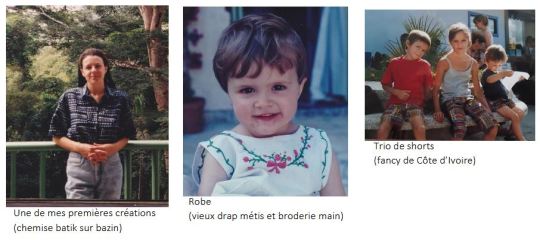
Je suis une autodidacte. J’ai commencé la couture au début des années 90 en Côte d’Ivoire. Ma sœur m’envoyait des patrons. C’était la grande époque des patrons Burda, quand les tutos sur internet n’existaient pas, internet n’en étant d’ailleurs qu’à ses balbutiements. Et avec des tissus achetés sur le marché (tie & dye, batik, wax, fancy, bazin…) j’ai fait mes premiers vêtements (jupes, chemises…). Je vois déjà certains hurler à l’appropriation culturelle (et oui je me suis même fait faire des tresses avec des rajouts). Grand bien leur fasse mais perso je préfère la notion d’appréciation culturelle. Quand mes enfants sont nés j’ai essayé de leur faire des vêtements un peu funky et en dehors des modes. J’ai aussi imaginé et cousus de nombreux costumes de carnaval dont certains plutôt originaux.

Depuis plusieurs années, on peut dire que j’ai une certaine expertise dans le domaine du costume d’époque Renaissance. Je crée des tenues aussi bien pour les gens du peuple que pour la plus haute noblesse. Dans un souci d’écologie, je ne travaille jamais avec des tissus neufs. L’upcycling est un des piliers de mon mode de création. J’utilise essentiellement des vieux draps mais également tous types de tissus que l’on me donne (coupons, vieux rideaux…). Le plus intéressant étant la phase de réflexion face à un bout de tissu et d’imaginer en quel costume je pourrais le transformer : homme, femme, peuple, bourgeois…
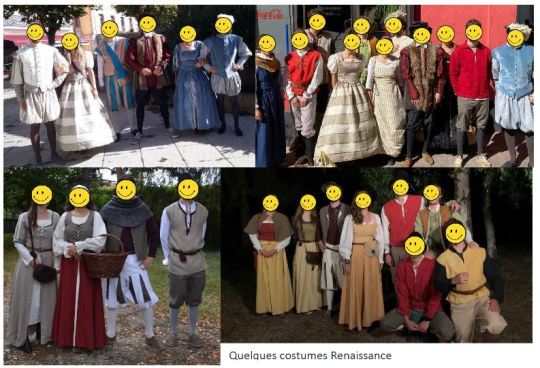
Je pratique les teintures végétales naturelles notamment pour les costumes faits dans de vieux draps blancs. Si des maisons de coutures ont des expériences dans ce domaines, je suis intéressée
pour partager avec elles. J’ai une petite expérience dans le tannage des peaux : peaux de mouton à mon adolescence et plus récemment peaux de renards.

Je serai heureuse d’échanger avec Baptiste, qui, comme j’ai pu
le lire, sait tanner les peaux et coudre le cuir.
Je peux vous envoyer un CV plus détaillé et des photos de mes réalisations car vous ne me trouverez pas sur les réseaux sociaux et je n’ai surtout pas de compte LinkedIn.
Côté organisation, comme Ted, j’aime assez travailler en scred. Du moins, j’aime bien le travail solitaire dans mon atelier. J’y passe beaucoup de temps notamment à concevoir mes projets. Cependant, j’aime aussi partager mes idées, échanger… Et l’idée d’une résidence de fabrication collective de costumes me séduit particulièrement. Je candidate donc pour ma maison de couture mais aussi, si elle accepte, je ne serai pas contre une candidature commune avec la maison de couture de ma consœur, et avant tout sœur, joëlle b.. Elle a bien plus de compétences techniques que moi, de nombreuses idées, c’est une spécialiste du sac et des accessoires et c’est surtout ma grande pourvoyeuse en tissu. De nos deux maisons pourrait naître une bien belle collection.
Voilà pour moi. En ce qui concerne les projets de ma maison de couture pour la Fashion Week de Cunlhat, j’envisage de travailler sur des vêtements d’inspirations Renaissance mais adaptés à la vie
du 21e siècle. Quoique mon expérience me fasse dire que les jeunes générations ne rechignent pas, bien au contraire, à revêtir longues jupes, basquines et autres hauts de chausses. J’aimerais concevoir une version contemporaine de ces vêtements tout en gardant une inspiration très Breughélienne (l’ancien précisons). Je pense travailler, comme à mon habitude avec des tissus de seconde main. J’envisage de me baser essentiellement sur de vieux draps comme matière première et utiliser des teintures végétales. Mais je ne peux pas en révéler plus pour préserver un peu de surprise et surtout pour ne pas être plagiée par des maisons de couture en manque
d’inspiration.
Les esquisses des autres maisons sont très enthousiasmantes et je soutiens en particulier le projet de Marie et Louis de défilé queer, féministe et drag ayant moi-même convenu que mes costumes ne devaient plus être genrés. Bien qu’adepte du no-bra, j’ai hâte de découvrir la ligne de sous-vêtements de Cécile. J’espère qu’elle nous proposera des pièces confortables.
Voilà, voilà. Et si vous ne retenez pas ma candidature ce n’est pas grave, je suis quand même intéressée par suivre vos activités, je vous demande d’ailleurs de me mettre sur la mailing list et je vais de ce pas m’abonner à « fashionweekdecunlhat ».
Bien à vous,
CD (moi et non Christian Dior)
2 notes
·
View notes
Text
Batik (Its history+ how its made)
Indonesia is where batik, a traditional textile art, first appeared. In order to produce patterns, fabric is first waxed before being dyed. The introduction of batik to West Africa occurred via trade networks and cross-cultural interactions. It evolved into a fundamental component of West African textile traditions over time, particularly in nations like Gambia, Mali, and Senegal. The vivid colours and intricate patterns of West African batik are already well-known.
The processes and methods used in batik and tie-dye are actually quite similar. Both require printing patterns on fabric using colours. Tie-dye includes folding, twisting, or tying the fabric before dying it. This results in a more abstract, free-flowing design.
These were some of the links which helped me learn about batik & tie dye in West Africa
youtube
youtube
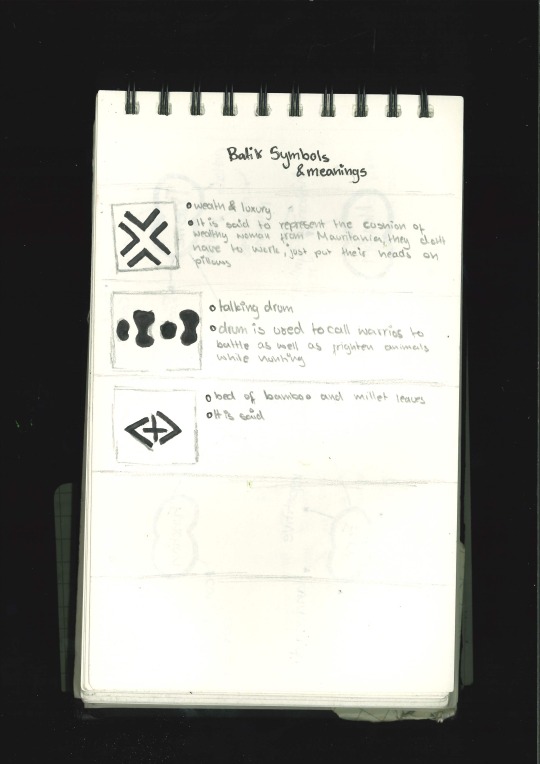
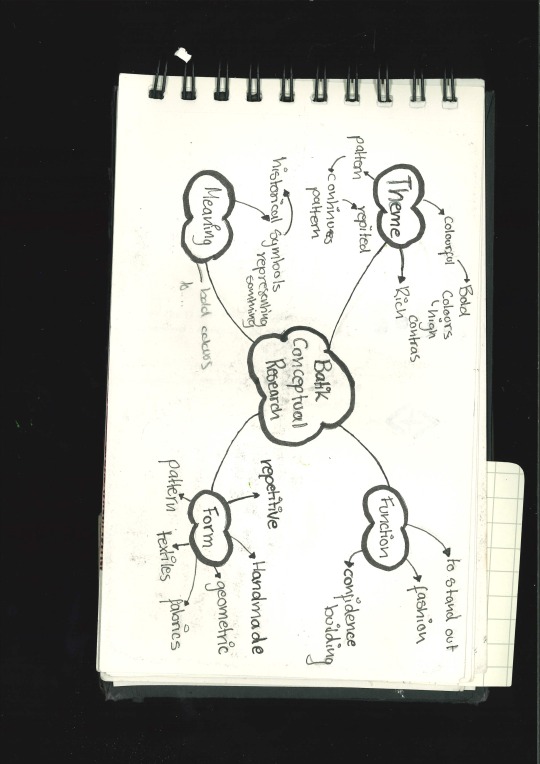
Visual Research

2 notes
·
View notes
Note
top fiveeeeeee fabric patterns, mayhaps? :3c
OH FUCK YES!!!!!!!!
(ok disclaimer for anyone who also sews, i am a quilter so i dont typically use a lot of fashion fabrics !!!! i still have some faves tho)
1. houndstooth (i used to be a huge heathers musical fan but all round i just love the pattern)
2. this is super broad but batik, or wax resist pattern dyeing!!! it has just a really gorgeous quality to the fabrics !!! (im partial to malaysian batik bc i love florals lol)
3. damask (the dense types with lots of detail r my faves, i never have a use for it in anything i make but its PRETTY. WHATEVER)
4. trellis (same as damask, i never have a use for it but i think its PRETTY)
5. shibori, specifically the miura technique!!! (i LOVE INDIGOOOOOO i wanted so badly to do a workshop on indigo dye techniques at my old hs but i cOULDNT MAKE IT)
#one day id love to make a quilt with some shibori elements ... i literally just have no time to sew lmao#TY FOR THE ASKKKK AHDBFJDNSKDHSKDN#asks#vaguely-annoyed
2 notes
·
View notes
Text
I think my Japanese class is slowly becoming convinced that I am some kind of fashion or clothing expert. Some things that have happened:
After a class survey, we were asked what we might want a guest speaker to talk about. One of the options was them letting us try on yukata. This was at the end of class, after a quiz, and after you finished you could leave. I was one of three people still filling out the survey, so when one guy asked what a yukata was, I was ready to launch into a whole thing about what they were, fabric type, occasions to wear them, how they were more casual than a kimono-I think I may have mentored nagajuban... my teacher was at the door, by the way.
Sharing lots of pictures of kimono on group discussions on art and such.
Sharing videos of the dyeing and weaving processes of kimono-crafting, and in particular comparing kyo-yuzen dyeing to wax resist in batik, because naturally everyone knows what that is.
Caught crocheting before class. Teacher asked a lot of questions about my experience.
In a recent grammar exercise, we were asked (aloud) for what reason we might be going to Tokyo. I said to visit Harajuku. Teacher then wanted to know why specifically I wanted to visit Harajuku, and I had to admit to the whole class I love the street fashion and just want to people watch (it should be noted I also said Harajuku bc I couldn't remember whether it was Akihabara or Shinjuku I also wanted to visit...a Google search tells me it's both of those as well, but I couldn't remember what specialized in what).
Wait until they find out I'm a) re-learning to knit, b) learning to embroider, and c) can't sew but intend to work on that this year
7 notes
·
View notes
Text
youtube
An informative insight into the batik technique and how to properly prepare fabric, how to apply the wax and the dyeing application process.
0 notes
Photo
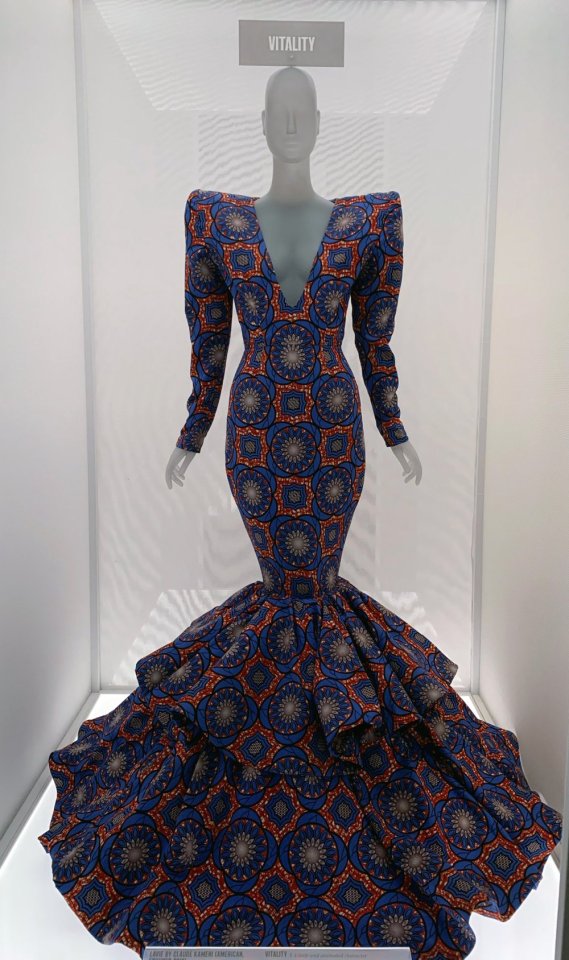
Dress
Claude Kameni
2021
VITALITY 1. Lively and animated character: In her designs, Claude Kameni uses fabrics often referred to as African wax prints. These vividly colored and densely patterned textiles, which have an enduring history of popular use in West and Central Africa, were originally inspired by batik, or wax-resist, cloth from Indonesia. The dynamism of Kameni’s work is indebted to the synergy she creates between these vibrant patterns, her strong silhouettes, and the body of the wearer. In this dress, the pattern is arranged to complement the curves of the figure and accentuate the flowing tiers of the skirt.
The MET; Image via @The Costume Institute Instagram
Currently on view: In America: A Lexicon of Fashion
#dress#fashion#fashion history#runway#claude kameni#2020s#21st century#wax print#2021#blue#red#orange#united states#the met
297 notes
·
View notes
Text
What is African wax print fabric?
African wax print fabric is a 100% cotton fabric most popular in West African countries, including. Nigeria, Ghana, Senegal, Gambia, Kenya and Tanzania.
History
African wax print fabric has its roots in Indonesian batik, which was brought to Africa by Dutch traders in the 19th century. The designs were initially produced in Holland and exported to the Dutch colonies in Indonesia, but were eventually brought to West Africa where they became popular.
In the early 20th century, European textile manufacturers began producing the fabric in Europe and exporting it to Africa. However, the fabric was not widely accepted by Africans until it was adapted to suit local tastes and needs. African entrepreneurs, particularly in Ghana and Nigeria, began producing their own versions of the fabric, incorporating local designs and motifs.
Today, the fabric is produced and worn throughout Africa, and has become an important part of African fashion. It is used to make traditional clothing such as dresses, skirts, and head wraps, as well as modern clothing such as shirts, pants, and even shoes.
BASIC STEPS IN AFRICAN WAX PRINT FABRIC PRODUCTION
1. Preparation
2. Raw cotton fibres
3. Spinning the cotton to make yarn
4. Using the yarn to produce grey cloth
- Design
- Wax Printing
- Indigo Dyeing
- Crackling Effect
- Colouration
- Washing
- Finishing
Production
African wax print fabric is produced through a process called wax-resist dyeing. The fabric is first washed and bleached, then a wax design is stamped or printed onto the fabric using a copper stamp or roller. The fabric is then dyed, and the wax is removed, leaving a design that is resistant to the dye. This process can be repeated multiple times to create intricate and colorful designs.
Symbolism
African wax print fabric has a rich symbolic meaning in African culture. The patterns and colors used in the fabric often have specific meanings related to cultural traditions, spirituality, and social status. For example, some patterns may be associated with specific tribes or regions, while others may be worn for special occasions such as weddings or funerals.
The fabric has also become a symbol of African identity and resistance, particularly during the colonial era. It was often worn as a symbol of African pride and cultural independence, and was even used as a form of protest against colonial rule.
Conclusion
African wax print fabric is a beautiful and important part of African culture and fashion. Its complex history and rich symbolism make it a fascinating subject of study, and its vibrant colors and designs make it a popular choice for clothing and accessories. Whether worn as a traditional garment or incorporated into modern styles, African wax print fabric in Rajkot, Gujarat will continue to be a symbol of African culture and identity for generations to come.
For more:
Where Can I Get Authentic African Fabric Supplier In India?
Why You Should Pay Attention To African Printed Fabric?
African Fabric Supplier In Zambia
1 note
·
View note
Text

Home ~ batik painting ~ American artist Janet Searfoss https://www.janetsearfossbatiks.com
“WAX PAINTING is an art form dating back 2,000 years. Wax Paintings were found in the tombs of Pharaohs and called "mummy portraits". . The Indonesian word “Batik” means “wax writing”. In our modern day society wax resist art is usually referred to as “Batik”. The process is also referred to as “ROZOME” in Japan. The Japanese version of batik consists of direct application of dyes and wax on silk using silk painting techniques. The Indonesian technique, usually uses cotton or silk and the wax is melted and applied using brushes or tjanting tools to the areas that are to remain that particular color then cloth is immersed into dyes and only the unwaxed areas accept the dye. This wax resist process of waxing out areas and dipping is repeated numerous times. Tjanting tools are made of a wooden shaft with a metal reservoir with a tiny metal tube that allows wax to flow onto the fabric leaving lines or dots. The waxed areas get bent and the cracks or fractures allow the dye to penetrate leaving fine lines of color referred to as “crackle” or “ice”. Janet refers to the crackle as the thumbprint of batik. Janet combines the BATIK techniques with painting techniques to create her own original style which she refers to as BATIK PAINTINGS. Some of the batiks incorporates pastels, silk screening with fabric paint, acrylic paint, colored pencil and other mix media. Janet will incorporate other art material necessary to create the image she visualizes.” The wax is removed through ironing the fabric between newsprint which absorbs the wax. The finished batik is drymounted onto foamcore, matted and framed.” ~ from her website above
17 notes
·
View notes